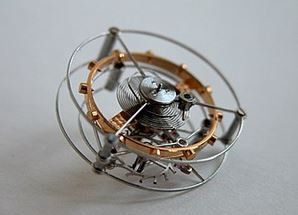Last updated on May 31, 2024
Watches with tourbillon complications are some of the most luxurious timepieces on the market. However, they are rare and many people outside of the watch-collecting community would ask the question, ‘What is a tourbillon?’. These fascinating and complex mechanisms are most often found on high-end and luxurious timepieces, made by the big names in the watchmaking industry. Watches with this complication tend to be highly priced reflecting the intricate artistry and watchmaking mastery required to build each timepiece. Tourbillon watches have been around for centuries and have been refined over time. Present-day tourbillon watches are remarkably precise and impeccably crafted, making them highly desired timepieces for those with expensive tastes. Tourbillon is French and is pronounced, “toor-bee-yawn”.
Although strictly speaking, it isn’t really a complication according to the definition of the term, as it doesn’t add an additional function to the timekeeping, a tourbillon is still considered an example of high-end watchmaking technology. However, many watch enthusiasts do consider it a complication and at Time Worn Watches, we will support that thought.
What is a tourbillon?
A tourbillon is a mechanical watch complication that aims to improve timekeeping accuracy by counteracting the effects of gravity on the watch’s movement. The mechanism consists of a rotating cage that holds the escapement, balance wheel, and hairspring of the watch. The cage rotates continuously, typically once per minute, so that the effects of gravity are distributed evenly throughout the watch’s movement. This helps to counteract any positional errors that could result in inaccuracies in timekeeping. We will go into more detail later in the post.
The history of the tourbillon?
The concept behind the tourbillon is attributed to the English watchmaker and inventor, John Arnold (1736 – 1799). It is not known when the idea was first conceived. However, at some point, the concept was shared with Abraham-Louis Breguet, the French watchmaker. Breguet completed his first working tourbillon in 1795. At the time, the movements used in pocket watches were affected by gravity due to how they were positioned upright in the pocket. Breguet’s goal was to create a more accurate timepiece by negating the effects of gravity.
The mechanism gets its name from the French word, tourbillon which translates to whirlwind in English. This is in reference to the spinning motion of the tourbillon complication. The original design was patented by Breguet in 1801. I believe the Brevet (Patent) number is 157. There is a current Breguet tourbillon that includes this reference on the dial as a nod to the original patent. This set a new standard for precision in timepieces, forcing other watchmakers to follow in his footsteps. Over the years, new variations of the tourbillon have been created. This includes the multi-axis, triple axis and double axis designs which all bring their own improvements to the complication.
Today, tourbillons are not needed as they once were as modern movements and materials are designed to negate the effects of gravity. However, tourbillons are often included in high-end watches as a complication that exhibits the ultimate in watchmaking skills. Wristwatches largely negate the need for tourbillons because the movement of the wrist means that the modern watch is rarely static.
How a tourbillon works
In a standard mechanical watch, the escapement is fixed, and it is impossible to regulate it to keep the exact same rate no matter which position that watch is in (dial up, down, crown up, down, etc.). Gravity can affect the accuracy of a fixed mechanical watch movement because it can cause positional errors in the balance wheel, hairspring, and escapement. For example, with a pocket watch sitting upright in a pocket, gravity will be pulling on the lower half of the hairspring causing it to stretch downwards. This will have an impact on how the balance wheel oscillates. These errors can cause the watch to run either fast or slow depending on its orientation.
The tourbillon was invented to counteract these effects by averaging out any positional errors caused by gravity. It achieves this by placing the balance wheel and the escapement of a watch in a rotating cage. The cage is slowly rotated, generally at a rate of one rotation per minute. This counteracts the effects of gravity and will reduce any positional errors of accuracy. The watchmaking skills required to build this complication mean that watches with tourbillons are very expensive. Typically, the tourbillon mechanism is usually exposed on the watch’s face to showcase it. They are often timepieces that are owned by very committed watch collectors.
Related content
Tourbillon at Wikipedia.

An interesting complication… out of my price range of course! It is not really needed for wristwatches. Pocket watches tend to stay in a static position, but with wristwatches, the movement of the wrist does the job of the tourbillon.
Hi Rehan, your point is correct, the tourbillon is more important with respect to timekeeping for pocket watches as opposed to wristwatches. They are still popular on high-end modern watches, not so much for the timekeeping, but due to the craftsmanship and history associated with the tourbillon complication. Thanks for taking the time to comment, Jason